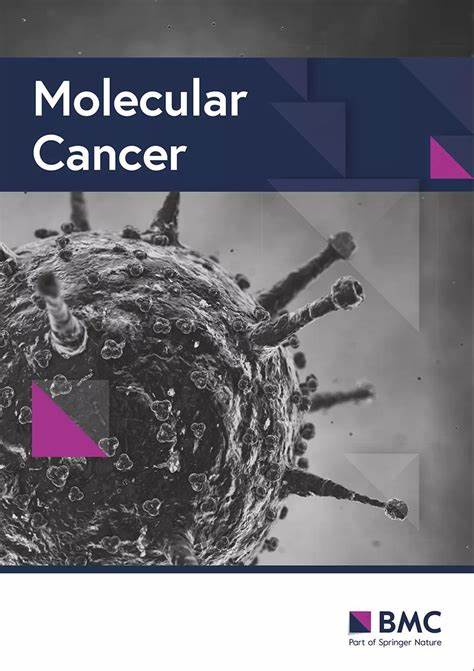Circular RNA circCLASP2 promotes nasopharyngeal carcinoma progression through binding to DHX9 to enhance PCMT1 translation
IF 27.7
1区 医学
Q1 BIOCHEMISTRY & MOLECULAR BIOLOGY
引用次数: 0
Abstract
Circular RNAs (circRNAs), characterized by their covalently closed-loop structures, constitute a distinct class of non-coding RNAs. They play pivotal regulatory roles within cells and are intricately associated with the progression of malignant tumors. However, their roles and the underlying mechanisms in nasopharyngeal carcinoma (NPC) progression have yet to be fully uncovered and comprehensively understood. Employing RNA sequencing technology, high-abundance circular RNAs in NPC were identified. Expression analysis of circCLASP2 in NPC tissues was conducted using quantitative real-time polymerase chain reaction (qRT-PCR) and in situ hybridization experiments. Through in vitro and in vivo functional assays, the influence of circCLASP2 on the proliferation and metastasis of NPC was investigated. LC–MS/MS technology analyzed the binding partners of circCLASP2, its differentially regulated targets, and the associated proteins of PCMT1. Interactions among circCLASP2, DHX9 protein, and PCMT1 mRNA were elucidated through RNA immunoprecipitation and RNA pull-down techniques. The effects of circCLASP2 and DHX9 on RNA G-quadruplex (rG4) structures and PCMT1 mRNA translation were explored through immunofluorescence (IF), ribosomal gradient separation, and dual-luciferase reporter assays. Immunoprecipitation (IP) revealed the downstream effector of the circCLASP2-DHX9-PCMT1 regulatory axis and Phalloidin staining confirmed its ultimate effect on the cytoskeleton. PDS treatment was applied for interventions in NPC, demonstrating potential therapeutic avenues. Our research revealed that circCLASP2, a novel circRNA that has not been reported in tumors, is upregulated in NPC and fosters cell proliferation and metastasis both in vitro and in vivo. Mechanistically, circCLASP2 acts as a molecular scaffold, facilitating the approximation of DHX9 to PCMT1 mRNA. DHX9 unwinds the inhibitory rG4 structure near the translation initiation site on PCMT1 mRNA, increasing PCMT1 expression. PCMT1 binds to and upregulates cytoskeleton-associated proteins, modulating cytoskeleton strength and dynamics and ultimately driving NPC cell proliferation and metastasis. In both in vitro and in vivo experiments, PDS significantly inhibits NPC growth and metastasis, showcasing promising therapeutic potential. Our investigation pinpointed a circular RNA, circCLASP2, which is upregulated in NPC and augments cytoskeletal functions via the DHX9-PCMT1 axis, contributing to the malignancy progression of NPC. This pathway holds promise as a potential therapeutic target for NPC. Furthermore, these molecules could also serve as biomarkers for adjunct diagnosis and prognosis assessment in NPC.环状RNA circlasp2通过与DHX9结合促进PCMT1的翻译,从而促进鼻咽癌的进展
环状 RNA(circRNA)具有共价闭环结构,是一类独特的非编码 RNA。它们在细胞内发挥着关键的调控作用,并与恶性肿瘤的进展密切相关。然而,它们在鼻咽癌(NPC)进展中的作用和内在机制尚未被完全揭示和全面了解。利用 RNA 测序技术,发现了鼻咽癌中的高丰度环状 RNA。利用实时定量聚合酶链反应(qRT-PCR)和原位杂交实验对circCLASP2在鼻咽癌组织中的表达进行了分析。通过体外和体内功能测试,研究了 circCLASP2 对鼻咽癌增殖和转移的影响。LC-MS/MS技术分析了circCLASP2的结合伙伴、其不同调控靶点以及PCMT1的相关蛋白。通过RNA免疫沉淀和RNA牵引技术阐明了circCLASP2、DHX9蛋白和PCMT1 mRNA之间的相互作用。通过免疫荧光(IF)、核糖体梯度分离和双荧光素酶报告实验,探讨了 circCLASP2 和 DHX9 对 RNA G-四叠体(rG4)结构和 PCMT1 mRNA 翻译的影响。免疫沉淀(IP)揭示了 circCLASP2-DHX9-PCMT1 调控轴的下游效应物,而胶冻蛋白染色则证实了其对细胞骨架的最终影响。PDS治疗被应用于鼻咽癌的干预,展示了潜在的治疗途径。我们的研究发现,circCLASP2是一种在肿瘤中从未报道过的新型circRNA,它在鼻咽癌中上调,并在体外和体内促进细胞增殖和转移。从机理上讲,circCLASP2 可作为分子支架,促进 DHX9 与 PCMT1 mRNA 的近似。DHX9 会解开 PCMT1 mRNA 翻译起始位点附近的抑制性 rG4 结构,从而增加 PCMT1 的表达。PCMT1 与细胞骨架相关蛋白结合并上调这些蛋白,从而调节细胞骨架的强度和动态,最终推动鼻咽癌细胞的增殖和转移。在体外和体内实验中,PDS 都能显著抑制鼻咽癌细胞的生长和转移,显示出良好的治疗潜力。我们的研究发现了一种环状 RNA,即 circCLASP2,它在鼻咽癌中上调,并通过 DHX9-PCMT1 轴增强细胞骨架功能,导致鼻咽癌的恶性进展。这一通路有望成为鼻咽癌的潜在治疗靶点。此外,这些分子还可以作为鼻咽癌辅助诊断和预后评估的生物标记物。
本文章由计算机程序翻译,如有差异,请以英文原文为准。
求助全文
约1分钟内获得全文
求助全文
来源期刊

Molecular Cancer
医学-生化与分子生物学
CiteScore
54.90
自引率
2.70%
发文量
224
审稿时长
2 months
期刊介绍:
Molecular Cancer is a platform that encourages the exchange of ideas and discoveries in the field of cancer research, particularly focusing on the molecular aspects. Our goal is to facilitate discussions and provide insights into various areas of cancer and related biomedical science. We welcome articles from basic, translational, and clinical research that contribute to the advancement of understanding, prevention, diagnosis, and treatment of cancer.
The scope of topics covered in Molecular Cancer is diverse and inclusive. These include, but are not limited to, cell and tumor biology, angiogenesis, utilizing animal models, understanding metastasis, exploring cancer antigens and the immune response, investigating cellular signaling and molecular biology, examining epidemiology, genetic and molecular profiling of cancer, identifying molecular targets, studying cancer stem cells, exploring DNA damage and repair mechanisms, analyzing cell cycle regulation, investigating apoptosis, exploring molecular virology, and evaluating vaccine and antibody-based cancer therapies.
Molecular Cancer serves as an important platform for sharing exciting discoveries in cancer-related research. It offers an unparalleled opportunity to communicate information to both specialists and the general public. The online presence of Molecular Cancer enables immediate publication of accepted articles and facilitates the presentation of large datasets and supplementary information. This ensures that new research is efficiently and rapidly disseminated to the scientific community.
 求助内容:
求助内容: 应助结果提醒方式:
应助结果提醒方式:


